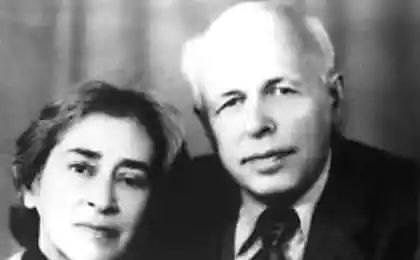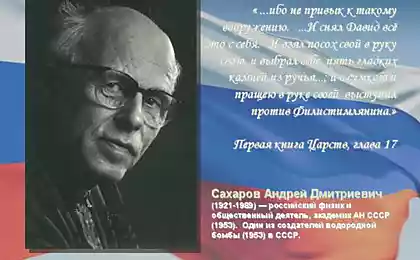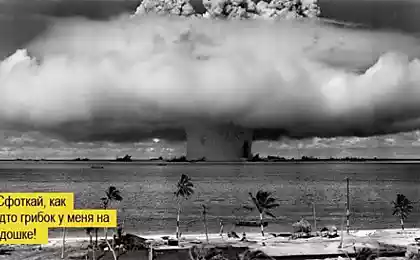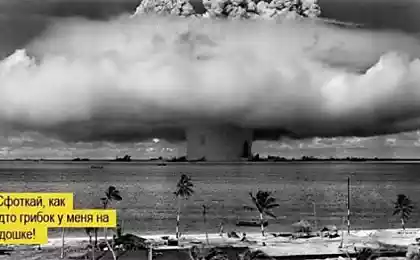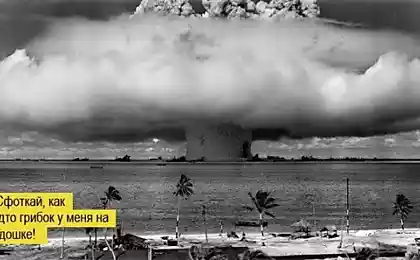839
Error Andrei Sakharov
Now, in an Internet era, everyone knows about Klaus Fuchs and other "nuclear spies", and it seems self-evident that the first Soviet atomic bomb - RDS-1 - was copied from the "Fat Man" bomb dropped on Nagasaki. But this is not true. Indeed, the size of the plutonium core, the shape and design of polonium-beryllium neutron source and the idea of implosion - implosion - were exactly taken from the American project. It's a lot, but not everything.
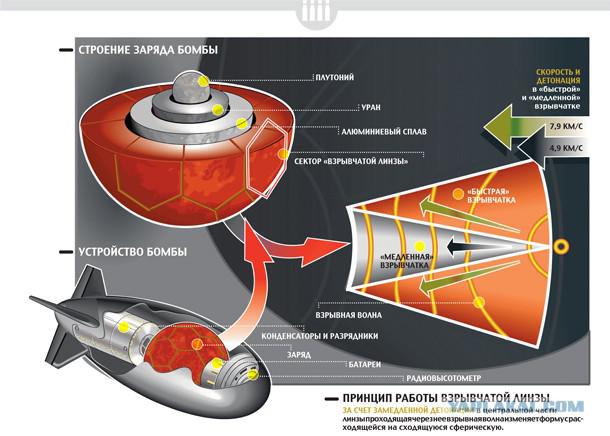
The fact that American bombs were used two types of explosives, Composition B and Baratol, their exact composition was not known Klaus Fuchs, and they were not made in the USSR. And the size and shape of the explosive lens formed spherical converging shock wave depend on these types of changes in the composition and literally a few percent of the geometry of the lens needs to be corrected.
In the RDS-1 instead of Composition B, containing 59, 5% RDX, 39, 5% and 1% of TNT or ceresin wax, use domestic alloy TG-50 (tie RDX and TNT). Instead baratola - inert material, do not blow up, only transmitting the shock wave with minimal loss. So the shape of the surface of our transition bombostroitelyam had refined by using the same methods - high-speed X-ray shooting - and inventing their own, no less witty. Have their own support systems and bombs, such as altimeter, barometric altimeter, automatic blasting so that the amount of development work was very large and well-known principle of work.
Add ease
But as the work on the first "product" RDS-1, the channels began to receive intelligence information that the Americans are working on even more powerful bomb. Much more powerful than the atomic. Our nuclear scientists were able to ask Nobel laureate Niels Bohr about the nature of the device of this bomb, but the great physicist, known for his sympathy for the Soviet Union, was not aware of the details, and his answer could not reassure our nuclear scientists. Therefore, the two groups have been established, whose task was to determine the possibility of an explosion in the bomb is not due to fission of heavy nuclei, but due to the fusion of light: of deuterium and tritium must be obtained helium and a neutron. The group, led by Igor Tamm was included young PhD Andrei Sakharov.
From the outset, Sakharov wanted to do absolutely secret military theme - he refused to go to the group, although he promised to help with housing and other material goods, which is desperately lacking in the post-war Moscow. In his memoirs, he wrote that twice refused offers of military and Kurchatov, but on the third time, in 1948, his consent has not been asked.
The main feature of talent Sakharov mentioned by all who worked with him, was that he could see the performance or correctness of any physical ideas without exact calculations, intuitive, it is not surprising that only a few months after he saw a diagram of the device future RDS-1, he got the idea to add to the uranium container surrounding the plutonium core, a layer of light elements. It happened in the autumn of 1948, before the first test. However, initially intended to use heavy water - like substance containing deuterium in the maximum volume concentration.
Proposal to use lithium deuteride instead of deuterium water came from VL Ginzburg, who due to "errors in the personal data" (his wife was convicted on political and after the conclusion of the article was exiled to Gorky) in the group was not included, and to most of the atomic secrets was not allowed. At lithium hydride was several decisive advantages as compared with the heavy water. Firstly, the solid, which simplifies the design and operation of nuclear greatly facilitates the explosive device.
Secondly, from the bombardment of lithium with neutrons obtained tritium, which comes in a fusion reaction with deuterium to release more energy than pure deuterium. Third, lithium is involved in slowing the neutrons (oxygen in the water for that too "heavy"). So the idea was accepted with great enthusiasm.
Guess at the first attempt
Construction, later known as "Puff Sakharov," seems obvious, but in fact the correct thickness of the layers was not easy to calculate. It is determined by the fact that lithium deuteride - a good neutron moderator, and uranium-238 reflects them. For more suited tritium slow neutrons. In the end, it turned out that the layers of light elements should be two, and uranium-238 - three. Not all factors yielded calculation, had the intuition theorists believe that mixing layers will not be catastrophic.
But first assembly was to compress the converging shock wave from the implosion of conventional explosives, and then light pressure from the X-ray "push the" it back, even with such a speed that the outer layers will not have time for internal! Due to this fusion, and a compression of the material and its adiabatic heating. But after that, despite the ongoing with fantastic chemical explosive expansion velocity of the former critical assembly, inside the "puff" yet there is an additional isothermal compression of light elements due to ionization of uranium-238, which absorbs X-rays exploding atomic "lighter".
This unexpected at first sight phenomenon called "saharizatsiey." And with the continued expansion of recently beautiful design of embedded balls begin and end as quickly pack of thermonuclear reactions - from the lithium-6 neutrons will produce tritium, it will react with deuterium, giving new thermonuclear neutrons, some of which will go to the new production of tritium, and some will divide 238, fragments of which will fly more neutrons, and the chain closes.
But this reaction is not self-sustaining, because it can only occur in a nonequilibrium state. Peak energy release takes a fraction of a microsecond, then expansion of the atoms will do the trick, the distance between them will increase so that the neutrons will cease to fall into their "target", and the response quickly damped. Therefore the "puff" is the optimal size, and Soviet physicists and gunsmiths it actually guessed it - the first attempt. Later, the British suffered "puff" at 720 kt, but the efficiency of her was much less.
The first "puff" was not cheap and convenient.
It was used at the same time all the ways to increase energy. And an inner layer of lithium contained a large amount (about a hundred grams) tritida lithium, so to speak, for the guarantee; because it does not receive the required tritium in the explosion, greatly reduces uncertainty and simplifies the calculations. A numerical calculations then had to conduct manual on adding machines. The use of tritium allowed to halve the army girls for adding machines. But tritium is very expensive, its preparation requires a large consumption of uranium-235, the half-life - about 12 years old, and very "volatile" as ordinary hydrogen.

Twenty times stronger
RDS-6s, despite the number was only the fourth nuclear test in the USSR, the structure with the numbers 4 and 5 were tested later. Ballistic body of this bomb looks much more perfect than used in RDS-1. Although the bomb was ready for discharge from the aircraft, it was decided to undermine her in the tower, in the center of the same fields as the RDS-1.
Scientific director of the Russian Federal Nuclear Center (RFNC) VNIIEF Radi Ivanovich Ilkaev explains the choice as follows: "When you reset the plane can be measured reliably only the power of the explosion, but all the early tests do even so-called physical experiments for the correct interpretation of the results that it was important to was not reflected from the ground shock wave - that is, to the center of energy was at the same height as the recording equipment ».
To test the new landfill had to "clean" - and bring bulldozers to remove radioactive soil. Were restored buildings, facilities and observation posts.
And now - a blast! Due to the twenty-fold increase energovyhoda its appearance was radically different from the earlier tested atomic charges. Without any physical experiments it was evident that structures survived the previous explosions shattered into dust. Hundred-ton scale model railroad bridge was thrown to 200 m. The brightness of the flash blinding even through dark glasses.
The official Tass said that "on August 12 was tested one type of the hydrogen bomb." Adherents of terminology say that properly considered a nuclear bomb fusion gain. But the main problem has been solved successfully: in the dimensions and weight of the RDS-1 created a charge that has 20 times more energovyhod.
The estimated capacity of the new "product" was 300 +/- 100 kt, but in reality bomb issued as nuclear physicists say, "at the upper end" - all 400 kt. This accuracy - +/- 30% - was a source of pride of the Soviet theorists of the Americans with calculation and hitting the predicted range was much worse. For example, the "Mike", the world's first thermonuclear explosion, the estimated equivalent of 1, 5-30 Mt, with the most likely estimate of 5 Mt, and measured - about 10, 4 Mm.
Against this background, the modest domestic 400 kt were more actual achievement, because the bomb was placed in a Tu-16 and old enough for combat use "tomorrow." Nevertheless put on stream production of such bombs was impossible, and was accepted into service version of this charge, not containing tritium - RDS-27 capacity of 250 kt.
Then, in early 1950, "puff" was second choice, because in question was the main performance scheme thermonuclear charge RDS-6t, which in American materials are called "classic Super." It worked on Klaus Fuchs, as he said to our scouts, but warn that this impasse, did not have time - Sakharov had to come to this yourself. There was another fallback - "just great" atomic bomb RDS-7.
It allows you to TNT equivalent of about the same as that of the RDS-6s, without all the new technologies, but ... little does not fit into the Tu-16. Similarly, Americans were insured by exploding a bomb of this type, two weeks after the first of the thermonuclear explosion "Mike».
Even the score
Merit "puff" not only in the fact that it allowed, albeit with reservations, "even the score" with American nuclear scientists. The development of RDS-6s led to the launch of concentrating production for lithium. Natural lithium consists of two isotopes with masses 6 and 7, and thermonuclear bomb is the best light isotope. Americans, says the director of VNIIEF Valentin Kostyukov, "scared" of settlement difficulties (using lithium maybe a lot of different fusion reactions, nuclear terminology - "channels", with the same initial atom) and did not engage in lithium in the early stages Fusion race.
Therefore, they are first "dry" without liquid deuterium fusion explosives contain natural or lithium, comprises a total of 7, 5% of the desired isotope, or partially enriched (40%). In Soviet bombs and warheads from the beginning used only the light isotope, making them lighter and more compact. For "puff" and also began development of tritium technologies - in all modern small warheads have to use tritium gain, but the developers RDS-6s were pioneers in the development of this capricious and treacherous nuclear material.
Yes, once appeared biphasic explosive devices, "puff" is outdated - but managed to play its role. 60 years separate us from the tests already closed the Semipalatinsk test site, for more than twenty years, did not rattle any nuclear explosions on the Russian firing range or in the US, and it certainly merits of a long-standing success of our nuclear scientists who have made a nuclear war from the inevitable - impossible.
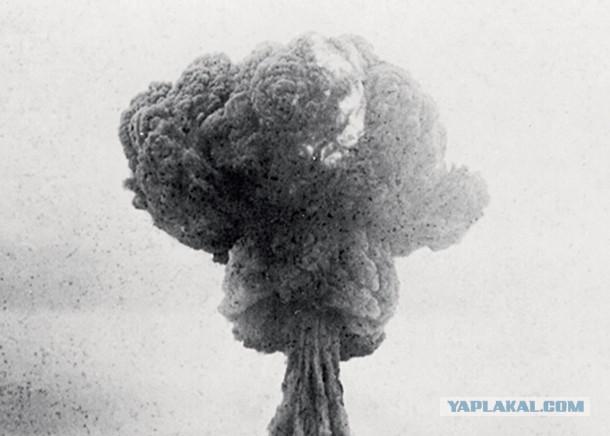
Source:

The fact that American bombs were used two types of explosives, Composition B and Baratol, their exact composition was not known Klaus Fuchs, and they were not made in the USSR. And the size and shape of the explosive lens formed spherical converging shock wave depend on these types of changes in the composition and literally a few percent of the geometry of the lens needs to be corrected.
In the RDS-1 instead of Composition B, containing 59, 5% RDX, 39, 5% and 1% of TNT or ceresin wax, use domestic alloy TG-50 (tie RDX and TNT). Instead baratola - inert material, do not blow up, only transmitting the shock wave with minimal loss. So the shape of the surface of our transition bombostroitelyam had refined by using the same methods - high-speed X-ray shooting - and inventing their own, no less witty. Have their own support systems and bombs, such as altimeter, barometric altimeter, automatic blasting so that the amount of development work was very large and well-known principle of work.
Add ease
But as the work on the first "product" RDS-1, the channels began to receive intelligence information that the Americans are working on even more powerful bomb. Much more powerful than the atomic. Our nuclear scientists were able to ask Nobel laureate Niels Bohr about the nature of the device of this bomb, but the great physicist, known for his sympathy for the Soviet Union, was not aware of the details, and his answer could not reassure our nuclear scientists. Therefore, the two groups have been established, whose task was to determine the possibility of an explosion in the bomb is not due to fission of heavy nuclei, but due to the fusion of light: of deuterium and tritium must be obtained helium and a neutron. The group, led by Igor Tamm was included young PhD Andrei Sakharov.
From the outset, Sakharov wanted to do absolutely secret military theme - he refused to go to the group, although he promised to help with housing and other material goods, which is desperately lacking in the post-war Moscow. In his memoirs, he wrote that twice refused offers of military and Kurchatov, but on the third time, in 1948, his consent has not been asked.
The main feature of talent Sakharov mentioned by all who worked with him, was that he could see the performance or correctness of any physical ideas without exact calculations, intuitive, it is not surprising that only a few months after he saw a diagram of the device future RDS-1, he got the idea to add to the uranium container surrounding the plutonium core, a layer of light elements. It happened in the autumn of 1948, before the first test. However, initially intended to use heavy water - like substance containing deuterium in the maximum volume concentration.
Proposal to use lithium deuteride instead of deuterium water came from VL Ginzburg, who due to "errors in the personal data" (his wife was convicted on political and after the conclusion of the article was exiled to Gorky) in the group was not included, and to most of the atomic secrets was not allowed. At lithium hydride was several decisive advantages as compared with the heavy water. Firstly, the solid, which simplifies the design and operation of nuclear greatly facilitates the explosive device.
Secondly, from the bombardment of lithium with neutrons obtained tritium, which comes in a fusion reaction with deuterium to release more energy than pure deuterium. Third, lithium is involved in slowing the neutrons (oxygen in the water for that too "heavy"). So the idea was accepted with great enthusiasm.
Guess at the first attempt
Construction, later known as "Puff Sakharov," seems obvious, but in fact the correct thickness of the layers was not easy to calculate. It is determined by the fact that lithium deuteride - a good neutron moderator, and uranium-238 reflects them. For more suited tritium slow neutrons. In the end, it turned out that the layers of light elements should be two, and uranium-238 - three. Not all factors yielded calculation, had the intuition theorists believe that mixing layers will not be catastrophic.
But first assembly was to compress the converging shock wave from the implosion of conventional explosives, and then light pressure from the X-ray "push the" it back, even with such a speed that the outer layers will not have time for internal! Due to this fusion, and a compression of the material and its adiabatic heating. But after that, despite the ongoing with fantastic chemical explosive expansion velocity of the former critical assembly, inside the "puff" yet there is an additional isothermal compression of light elements due to ionization of uranium-238, which absorbs X-rays exploding atomic "lighter".
This unexpected at first sight phenomenon called "saharizatsiey." And with the continued expansion of recently beautiful design of embedded balls begin and end as quickly pack of thermonuclear reactions - from the lithium-6 neutrons will produce tritium, it will react with deuterium, giving new thermonuclear neutrons, some of which will go to the new production of tritium, and some will divide 238, fragments of which will fly more neutrons, and the chain closes.
But this reaction is not self-sustaining, because it can only occur in a nonequilibrium state. Peak energy release takes a fraction of a microsecond, then expansion of the atoms will do the trick, the distance between them will increase so that the neutrons will cease to fall into their "target", and the response quickly damped. Therefore the "puff" is the optimal size, and Soviet physicists and gunsmiths it actually guessed it - the first attempt. Later, the British suffered "puff" at 720 kt, but the efficiency of her was much less.
The first "puff" was not cheap and convenient.
It was used at the same time all the ways to increase energy. And an inner layer of lithium contained a large amount (about a hundred grams) tritida lithium, so to speak, for the guarantee; because it does not receive the required tritium in the explosion, greatly reduces uncertainty and simplifies the calculations. A numerical calculations then had to conduct manual on adding machines. The use of tritium allowed to halve the army girls for adding machines. But tritium is very expensive, its preparation requires a large consumption of uranium-235, the half-life - about 12 years old, and very "volatile" as ordinary hydrogen.

Twenty times stronger
RDS-6s, despite the number was only the fourth nuclear test in the USSR, the structure with the numbers 4 and 5 were tested later. Ballistic body of this bomb looks much more perfect than used in RDS-1. Although the bomb was ready for discharge from the aircraft, it was decided to undermine her in the tower, in the center of the same fields as the RDS-1.
Scientific director of the Russian Federal Nuclear Center (RFNC) VNIIEF Radi Ivanovich Ilkaev explains the choice as follows: "When you reset the plane can be measured reliably only the power of the explosion, but all the early tests do even so-called physical experiments for the correct interpretation of the results that it was important to was not reflected from the ground shock wave - that is, to the center of energy was at the same height as the recording equipment ».
To test the new landfill had to "clean" - and bring bulldozers to remove radioactive soil. Were restored buildings, facilities and observation posts.
And now - a blast! Due to the twenty-fold increase energovyhoda its appearance was radically different from the earlier tested atomic charges. Without any physical experiments it was evident that structures survived the previous explosions shattered into dust. Hundred-ton scale model railroad bridge was thrown to 200 m. The brightness of the flash blinding even through dark glasses.
The official Tass said that "on August 12 was tested one type of the hydrogen bomb." Adherents of terminology say that properly considered a nuclear bomb fusion gain. But the main problem has been solved successfully: in the dimensions and weight of the RDS-1 created a charge that has 20 times more energovyhod.
The estimated capacity of the new "product" was 300 +/- 100 kt, but in reality bomb issued as nuclear physicists say, "at the upper end" - all 400 kt. This accuracy - +/- 30% - was a source of pride of the Soviet theorists of the Americans with calculation and hitting the predicted range was much worse. For example, the "Mike", the world's first thermonuclear explosion, the estimated equivalent of 1, 5-30 Mt, with the most likely estimate of 5 Mt, and measured - about 10, 4 Mm.
Against this background, the modest domestic 400 kt were more actual achievement, because the bomb was placed in a Tu-16 and old enough for combat use "tomorrow." Nevertheless put on stream production of such bombs was impossible, and was accepted into service version of this charge, not containing tritium - RDS-27 capacity of 250 kt.
Then, in early 1950, "puff" was second choice, because in question was the main performance scheme thermonuclear charge RDS-6t, which in American materials are called "classic Super." It worked on Klaus Fuchs, as he said to our scouts, but warn that this impasse, did not have time - Sakharov had to come to this yourself. There was another fallback - "just great" atomic bomb RDS-7.
It allows you to TNT equivalent of about the same as that of the RDS-6s, without all the new technologies, but ... little does not fit into the Tu-16. Similarly, Americans were insured by exploding a bomb of this type, two weeks after the first of the thermonuclear explosion "Mike».
Even the score
Merit "puff" not only in the fact that it allowed, albeit with reservations, "even the score" with American nuclear scientists. The development of RDS-6s led to the launch of concentrating production for lithium. Natural lithium consists of two isotopes with masses 6 and 7, and thermonuclear bomb is the best light isotope. Americans, says the director of VNIIEF Valentin Kostyukov, "scared" of settlement difficulties (using lithium maybe a lot of different fusion reactions, nuclear terminology - "channels", with the same initial atom) and did not engage in lithium in the early stages Fusion race.
Therefore, they are first "dry" without liquid deuterium fusion explosives contain natural or lithium, comprises a total of 7, 5% of the desired isotope, or partially enriched (40%). In Soviet bombs and warheads from the beginning used only the light isotope, making them lighter and more compact. For "puff" and also began development of tritium technologies - in all modern small warheads have to use tritium gain, but the developers RDS-6s were pioneers in the development of this capricious and treacherous nuclear material.
Yes, once appeared biphasic explosive devices, "puff" is outdated - but managed to play its role. 60 years separate us from the tests already closed the Semipalatinsk test site, for more than twenty years, did not rattle any nuclear explosions on the Russian firing range or in the US, and it certainly merits of a long-standing success of our nuclear scientists who have made a nuclear war from the inevitable - impossible.

Source:
